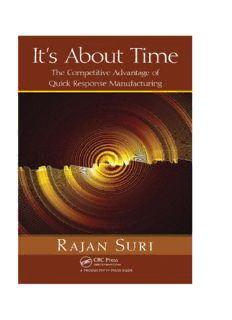
It's About Time: The Competitive Advantage of Quick Response Manufacturing PDF
Preview It's About Time: The Competitive Advantage of Quick Response Manufacturing
Disclaimer: This eBook does not include ancillary media that was packaged with the printed version of the book. It’s About Time The Competitive Advantage of Quick Response Manufacturing It’s About Time The Competitive Advantage of Quick Response Manufacturing R ajan Suri Productivity Press Taylor & Francis Group 270 Madison Avenue New York, NY 10016 © 2010 by Taylor and Francis Group, LLC Productivity Press is an imprint of Taylor & Francis Group, an Informa business No claim to original U.S. Government works Printed in the United States of America on acid-free paper 10 9 8 7 6 5 4 3 2 1 International Standard Book Number-13: 978-1-4398-0596-1 (Ebook-PDF) This book contains information obtained from authentic and highly regarded sources. Reasonable efforts have been made to publish reliable data and information, but the author and publisher cannot assume responsibility for the validity of all materials or the consequences of their use. The authors and publishers have attempted to trace the copyright holders of all material reproduced in this publication and apologize to copyright holders if permission to publish in this form has not been obtained. If any copyright material has not been acknowledged please write and let us know so we may rectify in any future reprint. Except as permitted under U.S. Copyright Law, no part of this book may be reprinted, reproduced, transmit- ted, or utilized in any form by any electronic, mechanical, or other means, now known or hereafter invented, including photocopying, microfilming, and recording, or in any information storage or retrieval system, without written permission from the publishers. For permission to photocopy or use material electronically from this work, please access www.copyright. com (http://www.copyright.com/) or contact the Copyright Clearance Center, Inc. (CCC), 222 Rosewood Drive, Danvers, MA 01923, 978-750-8400. CCC is a not-for-profit organization that provides licenses and registration for a variety of users. For organizations that have been granted a photocopy license by the CCC, a separate system of payment has been arranged. Trademark Notice: Product or corporate names may be trademarks or registered trademarks, and are used only for identification and explanation without intent to infringe. Visit the Taylor & Francis Web site at http://www.taylorandfrancis.com and the Productivity Press Web site at http://www.productivitypress.com To Nicole v Contents Contents of Bonus CD ........................................................................xiii Acknowledgments ................................................................................xv Introduction ........................................................................................xvii Chapter 1 The Power of Time .............................................................1 Defining QRM..............................................................................2 Challenges to Reducing Lead Time ...........................................4 QRM Focus Is Different from a Traditional Approach ..........8 Manufacturing Critical-path Time (MCT) ............................12 Keep Data-Gathering Efforts Simple ............................12 Measure in Calendar Time and Properly Quantify the Critical Path.................................13 An MCT Example ...........................................................14 Impact of MCT on Your Organization’s Performance ......................................................18 Enterprise-Wide Waste Due to Long MCT ................20 Impact of QRM—Standard Cost Prediction versus Actual Results ..................................................................23 Accounting Systems Miss the Connection ..................25 Encouraging Time-Based Thinking throughout the Organization ...............................................28 Rethinking the “On-Time Delivery” Metric .........................30 Dysfunctional Impact of the On-Time Delivery Metric ..................................................................31 The QRM Approach to Improving Delivery Performance .......................................................33 Squeezing Out Time Leads to Numerous Improvements ....33 Chapter 2 Organizational Structure for Quick Response: QRM Cells, Teamwork, and Ownership .......................35 Response Time Spirals ..............................................................36 The Spiral for a Make-to-Stock Business .....................36 The Spiral for a Make-to-Order Business ....................39 vii viii • Contents Roots of the Response Time Spirals .............................41 Four Structural Changes for Quick Response .......................47 Key 1: Organize into QRM Cells. .................................48 Understanding Focused Target Market Segment (FTMS) through an Example ..............................................48 Defining a QRM Cell .........................................50 Deciding Which Resources to Include in a QRM Cell: An Example ..................52 QRM Cells Are More Flexible than Traditional Cells .................................53 Key 2: Team Ownership ................................................56 Key 3: Significant Investment in Cross-Training ........57 Key 4: Relentless Focus on MCT Reduction ..............60 Understanding the QRM Number .................60 Ensuring Proper Application of the QRM Number ................................................63 Harnessing the Power of the Four Structural Keys ...............65 Chapter 3 Understanding and Exploiting System Dynamics Principles .........................................................................71 The Parable of the Landing Gear .............................................73 The Pitfall of High Utilization ..................................................75 Understanding the Magnifying Effect of Utilization ..76 Clarifying “Utilization” .....................................77 Clarifying “Flow Time” .....................................78 Putting It All Together ......................................79 The Miraculous Effect of Spare Capacity ....................80 Impact of Variability .......................................................81 Three-Pronged Strategy to Reduce Flow Time ......................83 Reduce AV, the Average Variability...............................83 Practical Strategies for Reducing Variability in Arrivals .......................84 Practical Strategies for Reducing Variability in Job Times ....................84 Reduce M, the Magnifying Effect of Utilization .........85 Reduce TJ, the Time per Job ..........................................87
Description: